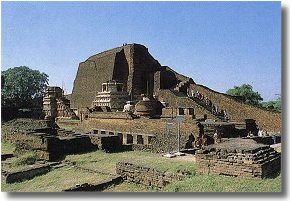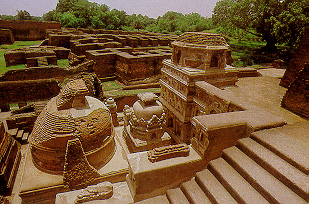SANGAM.ORG
Ilankai Tamil Sangam, USA, Inc.
Association of Tamils of Sri Lanka in the USA
Really Old School
by Jeffrey E. Garten, The New York Times Op-Ed, December 9, 2006
|
And second, is the Asian region any more than a series of nation-states obsessed with guarding their sovereignty — and do they have the ability to interact peacefully and constructively, much as the European Union is trying to do, to pool their individual strengths for the betterment of their region and the world beyond it?
|
 At a summit meeting of leaders next week in the Philippines, senior officials from India, Singapore, Japan and perhaps other countries are scheduled to discuss the revival of an ancient university in India called Nalanda. It is a topic unlikely to receive much mention in the Western press. But no one should underestimate the potential benefits of this project to Asia, or the influence it could have on Asia’s role in the world, or the revolutionary impact it could make on global higher education.
At a summit meeting of leaders next week in the Philippines, senior officials from India, Singapore, Japan and perhaps other countries are scheduled to discuss the revival of an ancient university in India called Nalanda. It is a topic unlikely to receive much mention in the Western press. But no one should underestimate the potential benefits of this project to Asia, or the influence it could have on Asia’s role in the world, or the revolutionary impact it could make on global higher education.
Americans are used to thinking about the rising powers of Asia — China, India, South Korea and even some of the smaller countries — primarily as formidable economic competitors. In the case of Beijing, we also recognize the potential for superpower political and military status. But there are at least two questions that are key to Asia’s future that we do not generally ask.
First, for all the talk about the rise of Asia in the “knowledge age” that we live in, are these countries ultimately constrained in their potential to be great nations by their lack of top-flight systems of higher education?
And second, is the Asian region any more than a series of nation-states obsessed with guarding their sovereignty — and do they have the ability to interact peacefully and constructively, much as the European Union is trying to do, to pool their individual strengths for the betterment of their region and the world beyond it?
The possibility of rebuilding Nalanda University goes to the heart of both those issues. Founded in 427 in northeastern India, not far from what is today the southern border of Nepal, and surviving until 1197, Nalanda was one of the first great universities in recorded history. It was devoted to Buddhist studies, but it also trained students in fine arts, medicine, mathematics, astronomy, politics and the art of war.
 The university was an architectural and environmental masterpiece. It had eight separate compounds, 10 temples, meditation halls, classrooms, lakes and parks. It had a nine-story library where monks meticulously copied books and documents so that individual scholars could have their own collections. It had dormitories for students, perhaps a first for an educational institution, housing 10,000 students in the university’s heyday and providing accommodations for 2,000 professors. Nalanda was also the most global university of its time, attracting pupils and scholars from Korea, Japan, China, Tibet, Indonesia, Persia and Turkey.
The university was an architectural and environmental masterpiece. It had eight separate compounds, 10 temples, meditation halls, classrooms, lakes and parks. It had a nine-story library where monks meticulously copied books and documents so that individual scholars could have their own collections. It had dormitories for students, perhaps a first for an educational institution, housing 10,000 students in the university’s heyday and providing accommodations for 2,000 professors. Nalanda was also the most global university of its time, attracting pupils and scholars from Korea, Japan, China, Tibet, Indonesia, Persia and Turkey.
The university died a slow death about the time that some of the great European universities, including those in Oxford, England, and Bologna, Italy, were just getting started, and more than half a millennium before Harvard or Yale were established. Its demise was a result of waning enthusiasm for Buddhism in India, declining financial support from successive Indian monarchs and corruption among university officials. The final straw was the burning of the buildings by Muslim invaders from what is now Afghanistan.
But Nalanda represents much of what Asia could use today — a great global university that reaches deep into the region’s underlying cultural heritage, restores many of the peaceful links among peoples and cultures that once existed, and gives Asia the kind of soft power of influence and attraction that it doesn’t have now. The West has a long tradition of rediscovering its ancient Greek and Roman roots, and is much stronger for that. Asia could and should do the same, using the Nalanda project as a springboard but creating a modern, future-oriented context for a new university.
At the Asian summit meeting next week, a consortium led by Singapore and including India, Japan and others will discuss raising the $500 million needed to build a new university in the vicinity of the old site and perhaps another $500 million to develop the roads and other infrastructure to make the institution work. The problem is that the key Asian officials are not thinking big enough. There is more talk about making Nalanda a cultural site or a center for philosophy than a first-rate modern university. The financial figures being thrown around are a fraction of the endowments of Harvard, Yale or Columbia today. A bolder vision is in order.
The rebuilt university should strive to be a great intellectual center, as the original Nalanda once was. This will be exceedingly difficult to achieve; even today, Asia’s best universities have a long way to go to be in the top tier. In a recent ranking of universities worldwide, Newsweek included only one Asian institution, the University of Tokyo, in the world’s top 25. In a similar tally by The Times of London, there are only three non-Western universities in the top 25.
The original Nalanda might have been the first to conduct rigorous entrance exams. The old university had world-class professors who did groundbreaking work in mathematical theorems and astronomy. It produced pre-eminent interpreters and translators of religious scriptures in many languages.
The new Nalanda should try to recapture the global connectedness of the old one. All of today’s great institutions of higher learning are straining to become more international in terms of their student body, their professors, their research and their course content. But Asian universities are way behind. A new Nalanda, starting as it will from scratch, could set a benchmark for mixing nationalities and cultures, for injecting energy and direction into global subjects and for developing true international leaders.
In the old days, Nalanda was a Buddhist university, but it was remarkably open to many interpretations of that religion. Today it could perform a vital role consistent with its original ethos — to be an institution devoted to religious reconciliation on a global scale.
Today, Nalanda’s opportunity is to exploit what is lacking in so many institutions of higher education. That includes great medical schools that focus on delivering health care to the poor, law schools that emphasize international law, business schools that focus on the billions of people who live on two dollars a day but who have the potential to become tomorrow’s middle class, and schools that focus intensely on global environmental issues. Can Asia pull this off? Financially, it should be easy. China’s foreign exchange reserves just broke all global records and reached $1 trillion. And Japan’s mountain of cash isn’t that far behind.
But the bigger issue is imagination and willpower. It is not clear that the Asian nations are prepared to unite behind anything concrete except trade agreements, either for their benefit or the world’s. It appears doubtful that with all their economic prowess, and their large armies, they understand that real power also comes from great ideas and from people who generate them, and that truly great universities are some of their strongest potential assets. I would like to be proved wrong in these judgments. How Asia approaches the resurrection of Nalanda will be a good test.
Jeffrey E. Garten, former dean of the Yale School of Management, is a professor of international trade and finance there.
© 1996-2025 Ilankai Tamil Sangam, USA, Inc.
 At a summit meeting of leaders next week in the Philippines, senior officials from India, Singapore, Japan and perhaps other countries are scheduled to discuss the revival of an ancient university in India called Nalanda. It is a topic unlikely to receive much mention in the Western press. But no one should underestimate the potential benefits of this project to Asia, or the influence it could have on Asia’s role in the world, or the revolutionary impact it could make on global higher education.
At a summit meeting of leaders next week in the Philippines, senior officials from India, Singapore, Japan and perhaps other countries are scheduled to discuss the revival of an ancient university in India called Nalanda. It is a topic unlikely to receive much mention in the Western press. But no one should underestimate the potential benefits of this project to Asia, or the influence it could have on Asia’s role in the world, or the revolutionary impact it could make on global higher education. The university was an architectural and environmental masterpiece. It had eight separate compounds, 10 temples, meditation halls, classrooms, lakes and parks. It had a nine-story library where monks meticulously copied books and documents so that individual scholars could have their own collections. It had dormitories for students, perhaps a first for an educational institution, housing 10,000 students in the university’s heyday and providing accommodations for 2,000 professors. Nalanda was also the most global university of its time, attracting pupils and scholars from Korea, Japan, China, Tibet, Indonesia, Persia and Turkey.
The university was an architectural and environmental masterpiece. It had eight separate compounds, 10 temples, meditation halls, classrooms, lakes and parks. It had a nine-story library where monks meticulously copied books and documents so that individual scholars could have their own collections. It had dormitories for students, perhaps a first for an educational institution, housing 10,000 students in the university’s heyday and providing accommodations for 2,000 professors. Nalanda was also the most global university of its time, attracting pupils and scholars from Korea, Japan, China, Tibet, Indonesia, Persia and Turkey.